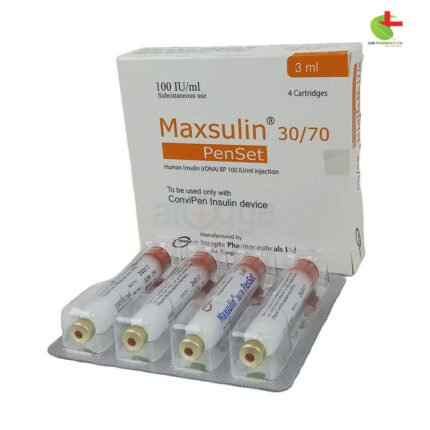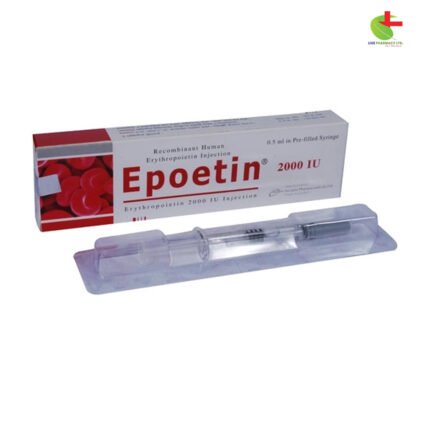Maxsulin Penset(50/50)
222.00৳ Cartridge
- Maxsulin Penset is an insulin delivery system for effective diabetes management.
- Convenient and easy-to-use, suitable for subcutaneous injections.
- Ensures precise dosing for both Type 1 and Type 2 diabetes patients.
 Brand
Brand
|
Incepta Pharmaceuticals Ltd |
|---|---|
 Generics
Generics
|
Human Insulin (rDNA) |
 Type
Type
|
Penset |
Indication
Diabetes Mellitus Management
Administration Instructions
Insulin should be administered subcutaneously either within 15 minutes before a meal or immediately after eating. Injection sites include the upper arm, thigh, or abdominal area, with absorption from the abdominal wall typically being faster than from other areas.
Adult Dosage
For Type 1 Diabetes Mellitus:
- Initial Guidelines:
- Ketones moderate or less: 0.5 U/kg/day via subcutaneous injection.
- Large ketones: 0.7 U/kg/day subcutaneously.
- Typically, 50-75% of the total daily dose is administered as intermediate- or long-acting insulin.
For Type 2 Diabetes Mellitus:
- Initial Guidelines:
- Start with 0.5 to 1 unit/kg/day in divided doses.
- Initial dosages for new patients are often lower, between 0.3 to 0.6 IU/kg/day.
- Like in Type 1, 50-75% of the total daily dose is given as intermediate- or long-acting insulin.
Morning Dosing:
- Administer two-thirds of the daily insulin dose subcutaneously.
- Regular to NPH insulin ratio: 1:2.
Evening Dosing:
- Administer one-third of the daily insulin dose subcutaneously.
- Regular to NPH insulin ratio: 1:1.
Dosing Considerations
Insulin dosages should be tailored based on individual blood and urine glucose levels, making careful adjustments to achieve optimal glucose control.
- For Type 1 Diabetes, dosage changes should be made in 2-unit increments.
- For Type 2 Diabetes, adjustments should be in 2-4 unit increments.
Regular blood glucose monitoring over at least three days is necessary before making changes.
Hepatic Impairment: Dose reductions may be necessary.
Pediatric Dosage
For Type 1 Diabetes Mellitus:
- Moderate ketones: 0.5 U/kg/day administered subcutaneously.
- Large ketones: 0.7 U/kg/day administered subcutaneously.
Renal Dosage
For patients with renal impairment, insulin dosages may need adjustment based on clinical response.
Contraindications
- Hypoglycemia
- Hypersensitivity to any components of the insulin formulation.
Mechanism of Action
Insulin helps to lower blood glucose levels by regulating carbohydrate, protein, and fat metabolism. It inhibits hepatic glucose production, limits lipolysis, and promotes peripheral glucose absorption.
Different insulin formulations are classified based on their duration of action: short-acting, intermediate-acting, or long-acting. For short-acting insulin, like soluble insulin (also known as ‘regular insulin’), the absorption is rapid. To prolong the action, insulin can be complexed with proteins (e.g., protamine zinc insulin or NPH insulin) or modified in particle size (e.g., insulin zinc suspensions). While most insulin is administered subcutaneously, soluble insulin can also be injected intravenously.
Precautions
- Pregnancy: Insulin requirements typically decrease in the first trimester and increase during the second and third.
- Caution in certain conditions: Reduced insulin needs may occur in cases of diarrhea, vomiting, hypothyroidism, and renal or hepatic impairment.
- Hypokalemia may occur.
- Caution for increased insulin needs: Fever, hyperthyroidism, trauma, infection, and surgery.
- Lactation: Safe for use while breastfeeding.
Side Effects
Common side effects may include:
- Allergic reactions
- Injection site reactions such as lipodystrophy or pruritus
- Lipatrophy
- Hypokalemia
- Blurred vision
- Hypoglycemia
Other possible side effects include: headache, flu-like symptoms, indigestion, diarrhea, back pain, and pharyngitis.
Drug Interactions
- Certain drugs such as oral hypoglycemic agents, MAO inhibitors, beta-blockers, ACE inhibitors, and salicylates may lower insulin requirements.
- Oral contraceptives, thiazides, glucocorticoids, and thyroid hormones may increase insulin needs.
- Alcohol can either enhance or reduce insulin’s hypoglycemic effects.
- Beta-blockers may mask hypoglycemia symptoms.













Reviews
There are no reviews yet.